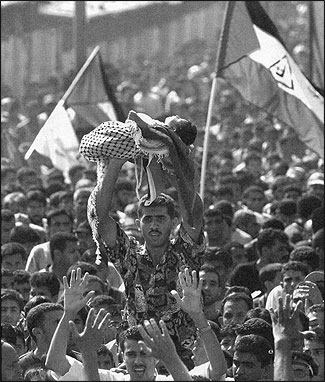
The body of an infant killed in the July 23, 2002 Israeli attack being held aloft during a procession in Gaza. Photo courtesy of Reuters.
At The Boston Globe, we never run photos of dead people without some discussion of the impact they are likely to have on our readers. This is particularly true of those appearing on Page One, where they are more likely to be seen by many members of a household, including children. And, of course, color adds to a photograph’s impact. This is a well-established editorial practice, which has evolved over years of readers responding to what we deliver in the morning: They’ve told us that they don’t want to be surprised by seeing such images during breakfast. They’ve said how disturbed their young children are when they see such pictures. And many readers complain that we are trying to take sides in some dispute by portraying a particular side as killers.
Yet, as editors, we know that certain images—because of their import and composition—belong in the newspaper, either on Page One or an inside page, because they reflect a crucial moment in a course of events. The picture of the screaming girl running from a napalm attack in Vietnam and the one of the firefighter carrying a dead baby in Oklahoma City come immediately to mind. And there are numerous others; the annual Pulitzer Prize-winning news photos comprise virtually an album of human tragedy.
This photograph—of an infant being carried in Gaza—is not only visually striking but also illustrates to our readers that something significant happened. In this case, Israeli forces had targeted a Hamas leader and killed him by sending a rocket into a residential area. This represented either a major shift in tactics or a serious lapse in military intelligence. And the result was that nine children died, a tragic consequence the Israelis have literally taken pains to avoid in the past.
Our decision to publish this photograph in color on Page One received little reader response. The picture is not gory, but the politics around it are troubling. Even within Israel, the attack prompted debate about whether it was the right thing to do. In our minds, this photograph clearly represented the deep emotions arising from this violent struggle in the Middle East and, for that reason, we decided to use it as the main art with the day’s lead news story.
Michael Larkin is deputy managing editor/news operations at The Boston Globe.



